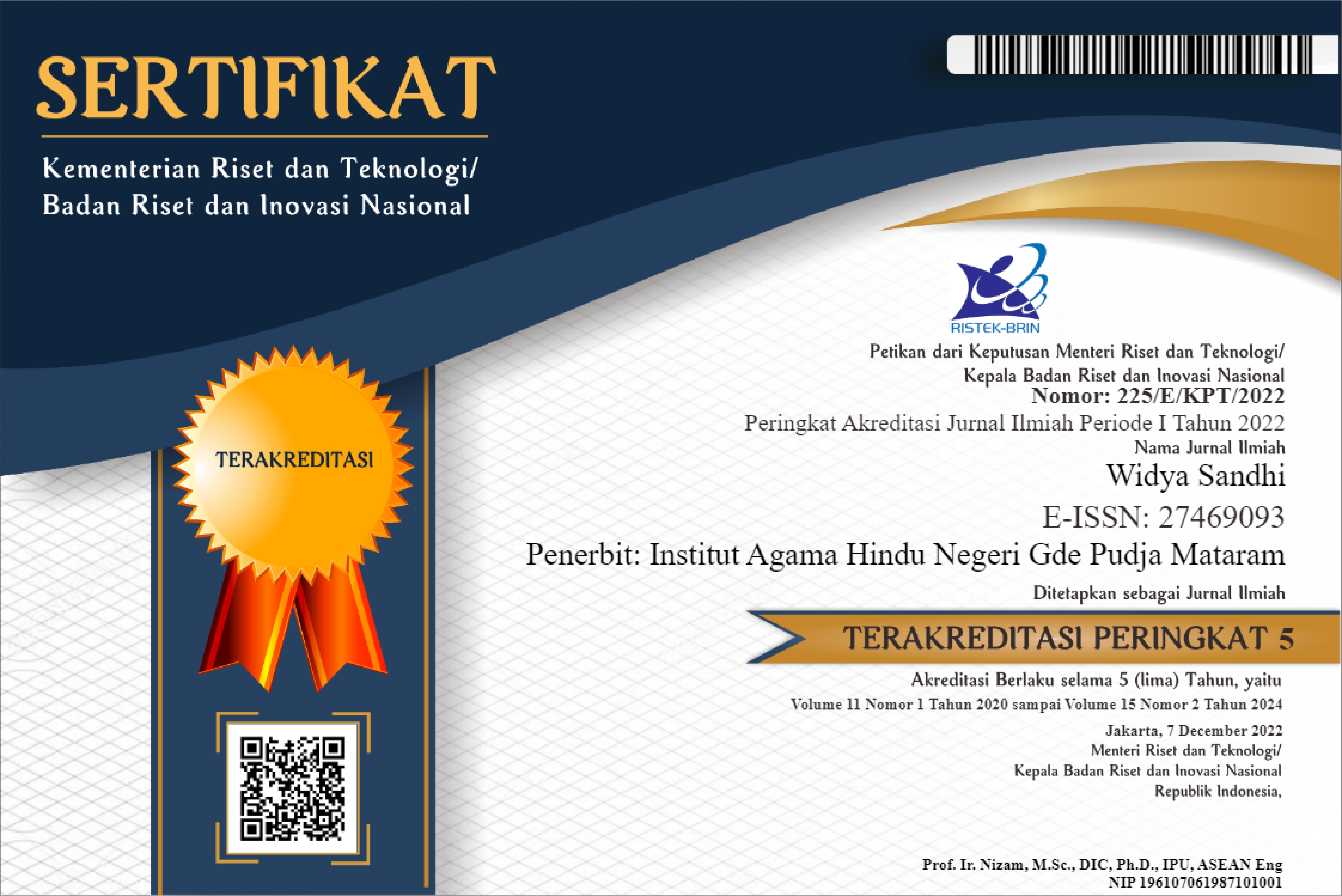KESUCIAN DIRI PINANDITA SEBAGAI MANGGALA DALAM PELAKSANAAN UPACARA YAJÑA
Abstract
This research was conducted to study the self-purity of pinandita as a Hindu saint who has the authority to lead the yajña ceremony. This study was designed in a type of interpretive qualitative research. The design of this study is more of a literature study because to study the aspects of pinandita's personal purity taken from a number of scriptural texts which are then interpreted to understand the meaning implied in the text.
The results of this study indicate that the process of cleansing a person to become a pinandita begins with doing pawintenan. The initiation process aims to purify a person to become a saint through the process of learning. After becoming pinandita there are a number of taboos that must be avoided in order to always maintain purity. In addition to taboos that must be avoided, a pinandita must also carry out self-purification activities, both physically and spiritually. Self-purification is very important for a pinandita because the authority attached to him in leading the implementation of Hindu ceremonies is in accordance with the yajña category held by Hindus
References
Darmayasa, Made, 2005. Keagungan Sapi Menurut Weda. Denpasar. Pustaka Manik Geni
Pedanda Kerta Arsa. Pelaksanaan Dewa Yadnya.
Pudja, 2010. Bhagawad Gita. Surabaya: Paramita
Rai Sudhartha, Tjocorda. 1991. Indik Kepemangkuan.
Sabda Pandita. 2005. Pedoman Pelaksanaan Diksa Maha Gotra Pasek Sanak Sapta Rsi. Denpasar
Surya, A.A. Ngurah Wijaya, 2009. Makanan Satwik dan Kesehatan. Paramita. Surabaya.
Maswinara, I Wayan. 2002. Brahmananda purana. Surabaya: paramita.
Widana, I Nyoman Murba, 2007. Tuntunan Praktis Dharmawacana bagi umat Hindu. Surabaya:Pt Paramita.
Pudja Gde, 2004. Bhagawad Gita (Pancama Veda). Surabaya; Pt Paramita.
Kajeng I Nyoman DKK, 2005. Sarasamuccaya dengan tek Bahasa Sansekerta dan Jawa Kuna. Surabaya: Pt Paramita.
Titib, I Made, 2003. Veda Sabda Suci Pedoman Praktis Kehidupan Surabaya: Paramita.
Tejanando Bikkhu : TT, Renungan menuju bijak.
Acharya Jaya, 2011. Pedoman Manggala Upacara Catur Yadnya. Mataram. Yayasan Dewi Saraswati.
Wirawan, I W.A. 2006. ”Dinamika dalam Sistem Simbol keagamaan pada Komunitas Hindu di kota Mataram, Provinsi Nusa Tenggara Barat: Sebuah Kaian Budaya”. Denpasar: Tesis Program Pascasarjana Universitas Udayana

This work is licensed under a Creative Commons Attribution-NonCommercial-ShareAlike 4.0 International License.
Authors who publish with this journal agree to the following terms:
- Authors retain copyright and grant the journal right of first publication with the work simultaneously licensed under a Creative Commons Attribution-ShareAlike 4.0 International License. that allows others to share the work with an acknowledgment of the work's authorship and initial publication in this journal.
- Authors are able to enter into separate, additional contractual arrangements for the non-exclusive distribution of the journal's published version of the work (e.g., post it to an institutional repository or publish it in a book), with an acknowledgment of its initial publication in this journal.
- Authors are permitted and encouraged to post their work online (e.g., in institutional repositories or on their website) prior to and during the submission process, as it can lead to productive exchanges, as well as earlier and greater citation of published work (See The Effect of Open Access).






.jpg)




